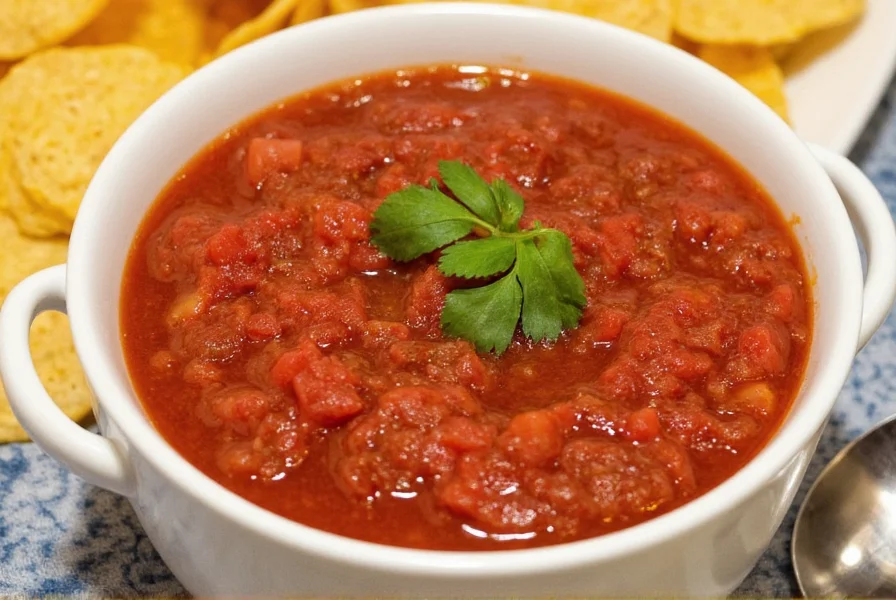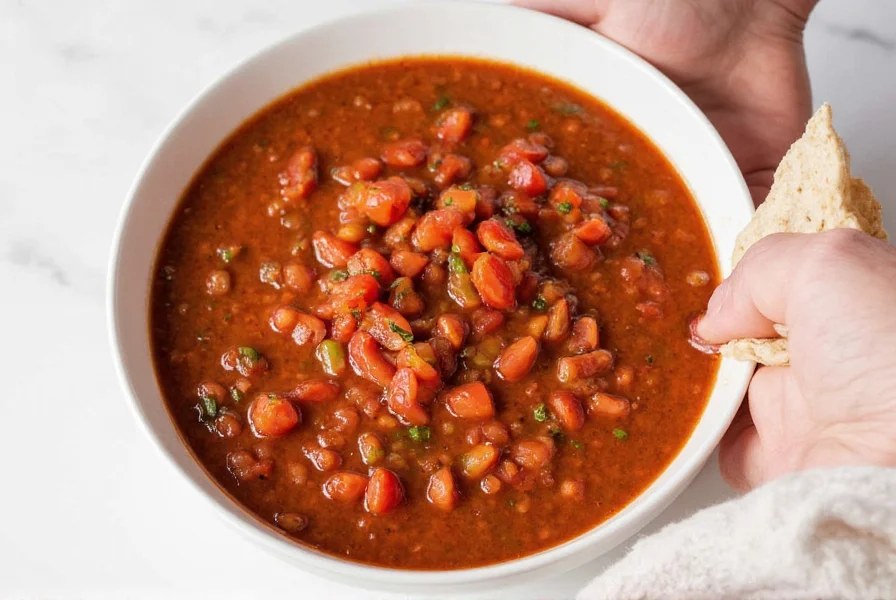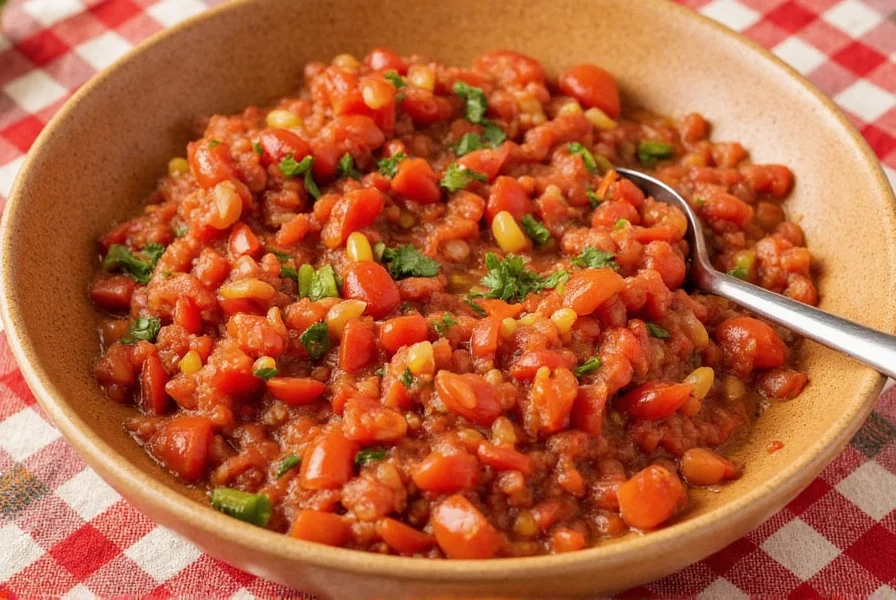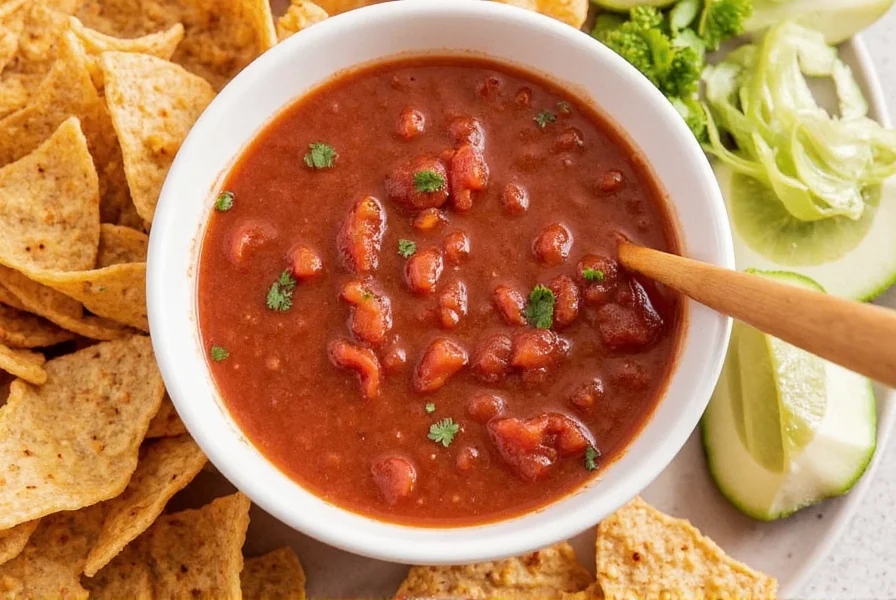Learn how to make perfect roasted tomato salsa with this easy step-by-step recipe. This smoky, flavorful salsa is perfect for tacos, dips, grilled meats, and more. Follow these simple steps to create a delicious condiment that elevates any dish.
| Traditional Salsa | Roasted Tomato Salsa |
|---|---|
| Fresh tomatoes, onions, cilantro, lime | Roasted tomatoes, garlic, chili, smoke, sweetness |
| Crunchy and zesty | Smoky, rich, and layered |
| Best served cold | Can be served warm or at room temperature |
Why Roasted Tomato Salsa?
Roasting tomatoes is a simple yet powerful technique that transforms their natural sugars and enhances their flavor profile. The process gives the salsa a deep, smoky undertone that can't be achieved with raw tomatoes alone. It's also a great way to use up overripe or slightly bruised tomatoes that might otherwise go to waste.
Essential Ingredients for Roasted Tomato Salsa
To make this incredible salsa, you'll need the following ingredients:
- 4-5 ripe tomatoes
- 1 onion
- 2 cloves of garlic
- 1-2 jalapeños (adjust to taste)
- Cilantro (optional)
- Lime juice
- Olive oil
- Salt and pepper
For an extra kick, you can add a pinch of smoked paprika or chipotle in adobo sauce.

Step-by-Step Guide to Making Roasted Tomato Salsa
Here's how to bring this magical salsa to life:
- Preheat oven to 400°F (200°C).
- Prepare the tomatoes: Cut them into halves or quarters, remove the seeds, and place them on a baking sheet.
- Add the rest of the ingredients: Toss the tomatoes with olive oil, chopped onion, minced garlic, sliced jalapeños, and any other desired spices.
- Roast for about 25–30 minutes until the tomatoes are softened and slightly charred around the edges.
- Let cool slightly, then transfer everything to a blender or food processor.
- Pulse until desired consistency—some people like it chunky, while others prefer it smooth.
- Season with salt, pepper, and a squeeze of lime juice.
- Chill for at least 30 minutes before serving to let the flavors meld.
Pro Tips for Perfect Roasted Tomato Salsa
Here are a few tips to ensure your roasted tomato salsa turns out perfectly every time:
- Use ripe tomatoes: They will roast better and have more natural sweetness.
- Don't skip the garlic: It adds depth and a subtle savory note.
- Adjust heat levels: If you're unsure about the spiciness, start with one jalapeño and add more if needed.
- Experiment with herbs: Cilantro is traditional, but you can also try adding parsley or basil for a different twist.
- Try different roasting times: A longer roast will give a deeper, more intense flavor, while a shorter time keeps it fresher.

How to Use Roasted Tomato Salsa
This versatile salsa can be used in a variety of ways:
- Tacos and burritos: Add a spoonful to your favorite fillings for a smoky, flavorful boost.
- Dips and snacks: Serve with tortilla chips, pita bread, or vegetable sticks.
- Grilled meats and seafood: Pair with grilled chicken, fish, or shrimp for a rich, complementary flavor.
- Stuffed peppers or eggplants: Use as a filling or topping for a hearty meal.
- Brunch dishes: Spread on toast, eggs, or avocado for a creative breakfast twist.

Buying Guide: Tools and Ingredients for Roasted Tomato Salsa
If you're planning to make roasted tomato salsa, here are some must-have tools and ingredients:
Essential Tools
- Blender or food processor: For blending the roasted ingredients into a smooth or chunky texture.
- Baking sheet: For roasting the tomatoes and other ingredients.
- Measuring cups and spoons: To accurately measure ingredients like garlic, jalapeños, and lime juice.
- Storage containers: To keep your salsa fresh in the fridge for several days.
Recommended Ingredients
- Organic tomatoes: Choose firm, ripe, and juicy tomatoes for the best results.
- Garlic bulbs: Fresh garlic adds a bold, aromatic flavor.
- Jalapeño peppers: For a mild to medium level of heat, depending on how many you use.
- Cilantro: Adds a bright, fresh note to the salsa.
- Lime: Provides acidity and brightness to balance the richness of the roasted tomatoes.
The Science Behind Roasting Tomatoes
Roasting tomatoes is not just about flavor—it's also a cooking technique that changes the chemistry of the fruit. When tomatoes are exposed to high heat, their natural sugars caramelize, and their water content evaporates, concentrating the flavor. This process also reduces the acidity, making the final salsa smoother and more complex in taste.
Additionally, the Maillard reaction occurs during roasting, which creates new flavor compounds and gives the tomatoes a deeper, more savory profile. This is why roasted tomato salsa has such a distinct and rich taste compared to its raw counterpart.

FAQs About Roasted Tomato Salsa
What are the two most important techniques for perfect roasted tomato salsa?
The two must-know techniques are: 1) Proper roasting temperature and timing - roasting at 400°F (200°C) for 25-30 minutes allows the tomatoes to caramelize properly without burning, creating that signature smoky-sweet flavor. 2) Flavor balancing after roasting - since roasting reduces acidity and concentrates sweetness, you'll need to adjust lime juice and salt after blending to achieve the perfect balance.
Can I make roasted tomato salsa without a food processor?
Yes! For a more traditional texture, you can finely chop all the roasted ingredients by hand. This creates a delicious pico de gallo style roasted salsa with more texture. Just be sure to let the ingredients cool enough to handle safely.
How long does roasted tomato salsa last in the refrigerator?
Properly stored in an airtight container, roasted tomato salsa will keep for 5-7 days in the refrigerator. The roasting process actually helps preserve the salsa compared to fresh salsa, as the reduced water content creates a less hospitable environment for bacteria.
Can I freeze roasted tomato salsa?
Absolutely! Roasted tomato salsa freezes beautifully for up to 3 months. The roasting process makes it more freezer-stable than fresh salsa. Just leave some headspace in your container as the salsa will expand when frozen. Thaw in the refrigerator overnight before using.
Why does my roasted tomato salsa taste bitter?
Bitterness usually comes from over-roasting (burning) the tomatoes or from roasting the tomato seeds and gel. Make sure to: 1) Remove most of the seeds before roasting, 2) Watch carefully during the last 5-10 minutes of roasting, and 3) If it's slightly bitter, add a pinch of sugar or honey to counteract the bitterness.
Can I can roasted tomato salsa for long-term storage?
Yes, but you must follow proper canning procedures. Roasted tomato salsa has less water content, which affects the pH balance. Use a tested canning recipe that accounts for the roasted ingredients, or process in a water bath for the appropriate time based on your recipe's acidity level.
What's the difference between roasted tomato salsa and tomato sauce?
While both start with roasted tomatoes, salsa maintains visible chunks of ingredients and has a brighter, more complex flavor profile with raw elements like fresh lime and cilantro added after roasting. Sauce is typically smoother, cooked longer, and lacks the fresh herbal notes that define salsa.
Conclusion
Roasted tomato salsa is a game-changer for anyone who loves bold, smoky flavors with a touch of sweetness. Whether you're a seasoned chef or a home cook with a passion for spices, this recipe is easy to make, incredibly versatile, and sure to impress your guests. With the right ingredients and a bit of patience, you can create a salsa that stands out from the crowd.
So next time you're planning a dinner party or just craving something new, give roasted tomato salsa a try. You might find it becomes your new favorite go-to condiment.











 浙公网安备
33010002000092号
浙公网安备
33010002000092号 浙B2-20120091-4
浙B2-20120091-4